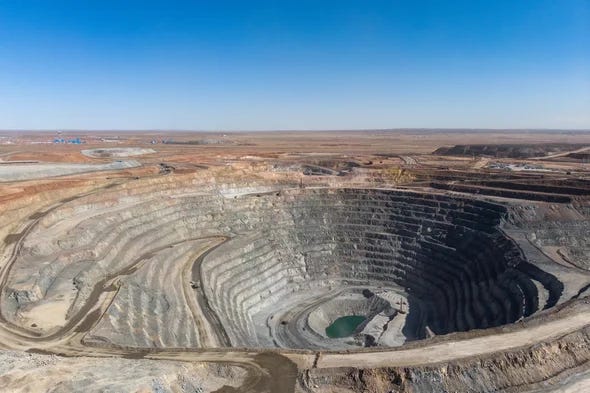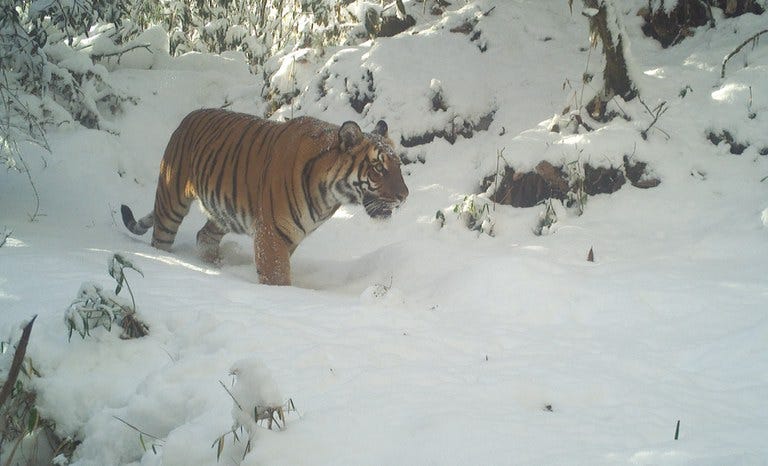The Weekly Anthropocene, August 9 2023
Deforestation continues to fall in Brazil, Norway's phosphorus discovery is really awesome news, tiger populations grow in Bhutan and India, and more!
Brazil

In July, The Weekly Anthropocene reported on the progress being made against deforestation in the Brazilian Amazon as the new administration of Brazilian President Lula da Silva (inaugurated January 2023) restarts enforcement of environmental laws after years of neglect and outright encouragement of crime under the notorious Bolsonaro. As we wrote then, satellite data has shown that this is already paying off: 2,649 square kilometers of the Brazilian Amazon were cut down in the first half of 2023 (January through June), down 34% from the nearly 4,000 kilometers cut down in the first half of 2022.
Now, new satellite data shows that deforestation is continuing to fall. In July 2023, 500 square kilometers of rainforest were cut down in Brazil, 66% lower than in July 2022 Relatedly, the total volume of fines imposed by the Brazilian government for illegal logging have risen 150% from January-July 2022 under Bolsonaro to January-July 2023 under Lula. A lot more fines against illegal logging…and a lot less illegal logging. Turns out that enforcing the law can make a big difference!
Furthermore, on August 8th and 9th, 2023, Lula is hosting an “Amazon Summit” in the Amazonian city of Belém, inviting representatives from the other seven Amazon Basin states, with the goal of renewing the long-moribund Amazon Cooperation Treaty Organization (ACTO) and perhaps forming an “Amazonian parliament.” COP30, the 2025 round of the annual UN climate talks, will also be held in Belém and will likely have some degree of special focus on the Amazon. At long last, things are beginning to look up for Earth’s largest rainforest.
This slowing of deforestation is part of a broader wave of progress in Brazil. Lula’s administration is close to finalizing a major tax reform that will substantially simplify doing business in Brazil, unifying what is currently a patchwork of state and town-level tax policies. Foreign direct investment and agricultural productivity in Brazil is rising, as are Brazilian grain exports to world markets, which are helping to fill the gap left by Russian attacks cutting off or intentionally destroying Ukrainian grain exports. The Brazilian government is also working to increase investment in renewable energy (a la America’s Inflation Reduction Act), and the energy minister hopes that a regulatory framework for offshore wind in Brazil will be passed by the end of the year. Solar power is already growing very rapidly in Brazil. Great news-and a lot of heartening possibilities for the future!
Mongolia

The United States is reaching out to Mongolia seeking collaboration on critical minerals1, as part of the Biden Administration’s broader efforts to create supply chains for solar, wind, EV, and battery minerals that are not dominated by China. Jose Fernandez, U.S. Under Secretary of State for economic growth, energy and the environment, (essentially America’s point person on critical minerals, among other duties) recently visited Mongolia. He told Scientific American that America is already offering technical support to Mongolia to help map their mineral resources. It can be inferred that the U.S.-led Minerals Security Partnership2 may soon be supporting critical minerals projects in Mongolia.
Norway
More detail has come out about the epoch-making Norway phosphate rock deposit discovery, which may be one of the most important news events of the year. The new reserves, discovered by Norge Mining in the Rogaland region, likely contain at least 70 billion tonnes of phosphate rock. (Phosphate rock is the major source of phosphorus, an element vital to Earth life’s biochemistry and used in a wide range of industrial processes). That’s enough to supply global demand for the next fifty years!
Some background on that: in 2021, before we knew about the Norway deposit, the U.S. Geological Survey calculated that Earth had 71 billion tonnes of proven phosphate rock reserves. As phosphorus demand is huge across many domains of human civilization, as a vital ingredient for technologies ranging from world-feeding fertilizer to solar panels to lithium iron phosphate batteries, many were concerned that we’d eventually use up this key resource. For years, entire science fiction stories and oodles of academic papers have been written about a looming mid-21st century phosphorus shortage, and now it’s just…not going to happen. The Norwegian government is fast-tracking a Rogaland phosphate rock mining project3, and active mining could begin as early as 2028. We’ll be good on phosphorus for a long while.
Human civilization’s accessible phosphorus reserves doubled this year! It’s like the entire planet found that we had twice as much money in the bank as we thought4. And all that unexpected extra phosphorus is in Norway, one of the most stable and democratic countries on the planet, and a firm Western ally. It might just has easily have been in Saudi Arabia or Russia. This is really, really good news! Everything from fertilizer production to battery building will be easier in the coming decades thanks to abundant Norwegian phosphorus. The future of civilization just got a bit brighter.
United States

The National Audubon Society, America’s leading bird conservation organization, issued a landmark report urging widespread building of power transmission lines to help protect birds from climate change, even though bird conservationists have historically tended to oppose power line projects due to the relatively small but real risk they pose to birds5. This is a big step forward for the legacy conservation movement, and could help unite Americans who care about the environment behind the most important issues on which we need to make fast progress!
The report, entitled “Birds and Transmission: Building the Grid Birds Need,” cites a wide array of studies and reports in developing its position. Key highlights include:
314 North American bird species are at risk of losing more than half their range due to climate change.
The National Renewable Energy Laboratory has found that the U.S. may need to build up to 10,000 miles of new power lines to reach 100% clean energy by 2035.
Transmission lines are generally taking absurdly long to make their way through the cumbersome permitting process6, though progress has been made recently thanks to strong support from the Biden Administration. The 520 mile SunZia power line, bringing New Mexico wind power to Arizona and California, was first introduced in 2006 but only got final federal approval in 2023; 15 years later. (The report doesn’t mention it, but SunZia is one of several such cases: the similar 732-mile TransWest Express power line, bringing Wyoming wind power to southern California, was first proposed in 2005 but only reached the ceremonial groundbreaking stage in June 2023; 18 years later). We need a lot more of those kinds of projects, much faster, to get to 100% clean energy7.
Conclusion: people who care about birds need to care about building more power lines and building them faster. There’s still room to advocate for bird-specific issues, of course: the Audubon Society partnered with the SunZia project and helped install an Audubon-developed ultraviolet light system to make the power lines more visible to birds, dramatically reducing collisions. (Pictured above: that system under development in Nebraska). Other conservation groups should follow their example: instead of opposing vital clean energy projects, help make them the best they can be!
The Audubon report, and their SunZia collaboration, represents essentially exactly what this newsletter has long been urging conservation groups to do: see the big picture and take appropriate action to support clean energy as the clear best choice for preserving much of Earth’s current biosphere from climate change, rather than oppose clean energy projects for short-sighted parochial reasons. Good news; let’s hope more local activists heed this call!
India and Bhutan
July 29 was International Tiger Day, and the governments of both immense India and the tiny Himalayan kingdom of Bhutan took the opportunity to release new data-driven estimates of their tiger populations. Bhutan recorded 131 tigers, up from 103 in 2015. And India reported that it likely had 3,682 tigers, up from an estimated 1,827 in 1972 thanks to decades of strong conservation efforts. Notably, as there are only about 4,500 non-captive tigers in the world (a number that thanks to incredible conservation progress is stable and potentially increasing despite severe poaching threats)8, this makes India home to more than 75% of the world’s wild tigers. Good work!
Here’s the official USGS list of critical minerals, which is a technological/economic classification, not a geological one. Minerals that the USA considers critical include lithium, nickel, cobalt, and the broader group of “rare earth elements,” like neodymium and europium.
A multi-nation partnership including the USA, UK, European Union, India, and many others, dedicated to sourcing critical minerals in environmentally, economically, and ethically sound manner. Essentially, the “Don’t Let China Run The Show on Critical Minerals” club.
A Norwegian government minister clarified that Norway plans to run the mine in a highly environmentally conscious manner, keeping carbon emissions as low as possible, ensuring no pollution of local waterbodies, and potentially shipping waste rock to Europe to be used to help shore up coasts against sea level rise.
If we used a bunch of different currencies representing different elements, and our money was only minted in stars and dispersed through the cosmos by supernovae and….okay, you know what, the money/phosphorus analogy isn’t quite accurate. Fun, though.
In the United States, an estimated 365 million birds are killed each year by collisions with buildings, 89 million by collisions with vehicles, and 57 million or less by collisions with power lines. But all of this is a sideshow compared to the biggest threat to birds in the US: outdoor cats, which kill an estimated 2.4 billion (2,400 million) birds per year. Power lines are not the real problem here.
Unsurprisingly, given the disproportionate hurdles they have to deal with. As Heatmap News reports: “A new transmission project must generally seek approval from every city, county, and state that it passes through. A new natural-gas pipeline, by comparison, only needs to be approved by FERC [the Federal Energy Regulatory Commission].” This is why this newsletter keeps urging environmentalists to support permitting reform and pro-building measures; the status quo is insanely biased towards fossil fuels!
There’s a lot of interesting work going on trying to speed up transmission line permitting: after Congressional action towards permitting reform stalled out, the Federal Energy Regulatory Commission is trying to finalize a new regulation to make transmission lines easier to build. Heatmap News recently reported that Democratic Senate Majority Leader Chuck Schumer has sent FERC an official letter urging them to make it happen.
See The Weekly Anthropocene’s Deep Dive on Big Cats for more.





I will take the wins wherever I can get them!
Norway uses its oil for a Sovereign wealth fund, will they be doing the same with the Phosphate?